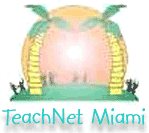|
Discovering a Dynamic
Underwater World
How it Works:
This interactive unit on the ocean involves various activities that seek to
inform children about the world's oceans and how to protect them from
pollution and destruction. Without leaving home or the classroom, children can
discover the ocean and its creatures by reading, creating art projects,
searching the Internet and conducting science experiments. For example, tides
and waves are explained through an art project in which students create a tide
mobile.
Students are introduced to tides and waves by visiting a website which
describes how tides are formed though pictures and animations. After becoming
familiar with tides, students will then use various art materials to re-create
what they saw at the website. The students will also use Microsoft word to
type up an explanation on how their tide mobile works. Children will also be
exposed to the beauty of coral reefs through books, The Magic School
Bus pictures, and science experiments. The ultimate goal for creating this
unit, is to instill in children how important it is to conserve ocean life, to
keep the ocean waters clean and to protect different kinds of ocean life from
becoming extinct.
Standards:
-To identify important fact about the ocean.
-To identify food chains in the ocean.
-To identify what causes tides and waves.
-To identify various sea life living inside the ocean.
-To use technology tools to process data and report results.
-To use technology tools to enhance learning and increase productivity and
creativity.
Estimated Class Periods To Complete:
8
Software and Materials Used:
Students will need to have access to a computer that is hooked up
to the Internet and have Microsoft Word. Teachers should use an overhead
projector as a teaching tool.
Keywords:
coral reefs, tides, oceans, underwater adventures, science experiments
Students:
The students involved in this project are gifted third grade students
working at or above the third grade level. They all have experience using
computers and are able to search the Internet and use Microsoft Word. The
students worked in cooperative groups to accomplish most of their goals for
this unit.
Overall Value:
The best innovative feature about this unit is a power point presentation
about various sea animals. After researching facts and important information,
students created a page that represented what they had learned. As the class
sat and watched this "mini-movie" they were quite impressed with
themselves and their classmates. Teachers would want to adapt this unit to
their lessons because it involves all cognitive modalities during the learning
process. Students are listening, reading, speaking, and creating throughout
this unit on the ocean.
Tips:
Students should be accustomed to working in cooperative groups before
using this unit. Furthermore, appoint 2-3 children as technology specialists.
These children should be able to help the other kids who are having difficulty
using the computer.
|
About The Teacher:
Rochelle Sklar is currently a third grade gifted teacher. She has earned her
Bachelor's degree in Elementary Education and a Master's degree in English for
speakers of other languages.(ESOL) In the near future, Rochelle would like to
attain a specialist degree in Math and Science to further enhance her teaching
skills in these areas. Rochelle loves to employ new and innovative teaching
styles in the classroom which almost always involves technology. She enjoys
taking her children on wondrous adventures through thematic units which
incorporate all the subject areas. Furthermore, she wishes that all her
students become lifetime learners. Her class also participates in the Citibank
FamilyTech program which provides computers and computer training to teachers,
parents and students.
Subjects:
Science and English
Grades:
Three through Five
Email Rochelle
|

